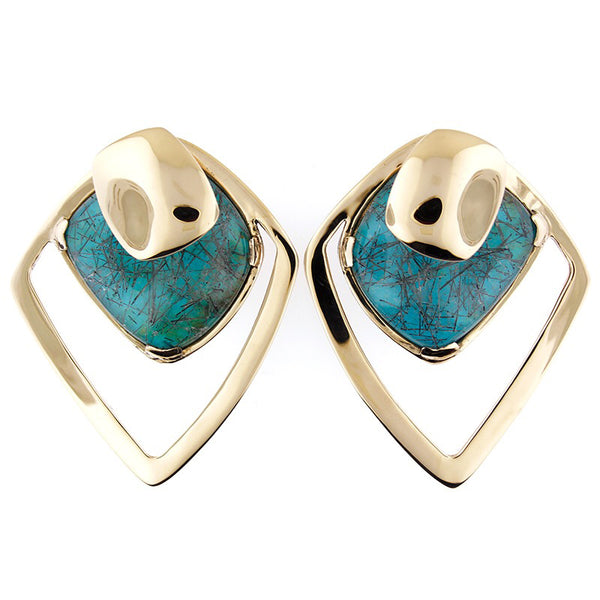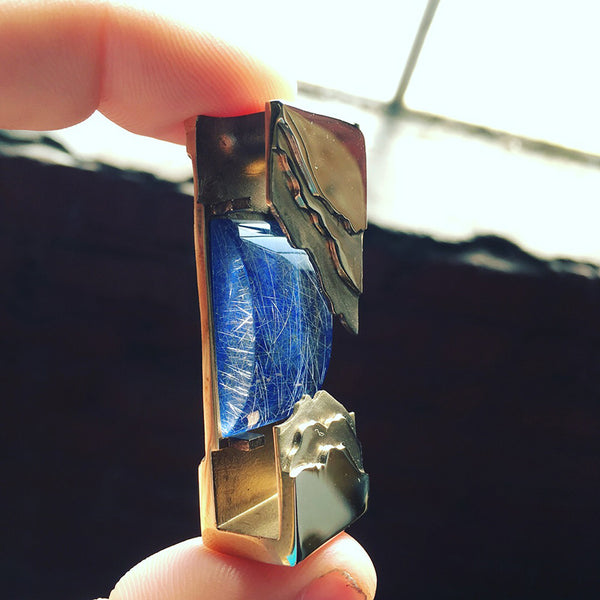Alchemy with Stone: Doublets and Triplets

iona ear weights with tourmaline included quartz and turquoise doublets
I've been experimenting with a new process that allows me to create unique, one of a kind gemstones with a modern aesthetic that embraces the distinctive color and light play characteristics of each stone. These gems are combinations of multiple stones laminated together and are named for the number of layers of stone in the completed piece. Two layers is a doublet, and three is called a triplet.

iona doublet inlays with tourmaline included quartz over turquoise that has been carved to reveal translucency
The technique of stone lamination to create composite gemstones has been used in the lapidary arts for thousands of years as a way to create more stable gems from fragile or valuable materials such as opal or ammolite. Thin slices of valuable gem material and a harder (or cheaper) stone are adhered together to increase rigidity and allow very thin, awkwardly shaped, or otherwise unusable pieces of fine gem material to be carved for jewelry and other decorative uses.
This technique has also been used by dishonest jewelers to defraud buyers by setting and selling gemstones with only a little precious material and a lot of inflated value. As far back as Pliny the Elder, clever artisans were using laminations:
"Sardonyx, for example, is imitated by cementing together three other precious stones, in such a way that no skill can detect the fraud; a black stone being used for the purpose, a white stone, and one of a vermilion colour, each of them, in its own way, a stone of high repute." (Bostock and Riley, 1855)
Why is this technique worth revisiting in a modern fine jewelry context?

Soma ear weights with doublet inlays created with rutilated quartz and turquoise
Freedom. Synergy. Fun. The creation of a new, unique aesthetic that takes characteristics from multiple stones and creates something dramatic. The ability to make light reactive stones more ethereal and otherworldly. The introduction of translucency into firmly opaque materials that do not naturally allow light to pass through. Gemstone alchemy.

Topo ear weights with rutilated quartz and lapis doublets, shown from the side to reveal interesting light play and transmitted color
It seems easy at a glance:
Step 1: Cut two (or more) stones.
Step 2: Glue them together.
Step 3: Party.
As with most seemingly simple things, doing it well is complicated. Let's have a look at the process.
Choosing the right materials
My doublets (two-layered stones) and triplets (three-layered stones) start with a careful selection of the material.
The top layer is usually a translucent quartz variant that provides a lens which magnifies color and can intensify the light play effects. This layer must be a high-quality material with exceptional clarity, and if included, must be cut at the correct angle and thickness for the inclusions and colored layers below to work together. Quartz is plentiful and cheap, but high grade rutilated quartz and hyper clear quartz can be more valuable than the other gems. The flawless clear quartz used on some of my new doublets and triplets is sometimes more valuable than the equivalent amount of semi-precious gemstone underneath it.
The colorful or light reactive material that is to be the focal point of the design must be stable and have excellent color density or light play because it is cut as one of the thinnest layers in the finished gem. Thin cuts often dilute color or diminish the light play, so this selection is integral to a quality finished gem.

From top: triplet quartz over moonstone over black jade, triplet quartz over moonstone over lapis, triplet quartz over labradorite over black jade
Some stones (triplets) have a third layer on the bottom - I do this to create a background color that is seen through other translucent materials. For example, both moonstone and labradorite become translucent when cut thin, and this can negatively affect the strength of the flashy light play for which these stones are known. Backing labradorite with black jade gives a dark background and explosive flash. The addition of high dome quartz magnifies the flash and creates a moody stone where the light play dances and changes with movement. Backing moonstone with lapis lazuli creates a striking gem with a blue background and foggy white light play. Again, the addition of high dome quartz pushes an already unique combination over the top.

Doublets with rutilated quartz over Turkish Purple Jade

Doublets with rutilated quartz over black jade
The last material is the adhesive itself. It must have a combination of characteristics that allow for a strong bond, a reasonable cure time, and water clarity with no color tint or chance of yellowing over time. After several experiments, I've settled on a two-part epoxy which I heat cure with UV exposure.
A note about the use of adhesive: I do not use adhesives as a method for constructing finished jewelry. I do not believe using glues as a primary connection between jewelry materials (like an inlay into a plug or a stone into a setting) results in a quality, best-effort product. Where this technique differs is the idea of creating a standalone object (a doublet or triplet) which is carved, polished, and set into jewelry with bezel or prong hardware as if it were a solid gem. I use adhesives to create a gemstone but not to attach the stone to any other element of a design.
The Process
Rushing a laminated stone will result in a poor quality gem. The time invested in material selection, properly polishing each layer, and adequately bonding them together translates into a gemstone where all elements work together and no signs of shoddy craft are visible.
Many doublets and triplets have been made with raw cut or roughly ground stones adhered together. I suppose this is okay if you are backing a thin opaque material with another stone to increase strength. However, with any transparency, those rough grinding marks can become visible at certain angles under different lighting conditions. I don't buy the idea that the adhesive will make those flaws "invisible" to the eye. Especially in my larger compositions (the inlays in my iona weights are almost 38mm/1.5" corner to corner, which is a very large doublet), there is so much surface area that the lensing effect of a translucent top layer can highlight a rushed polish job. Each inner layer of my stone laminations undergoes several stages of polishing to remove scratches and ensure true flatness. My target is a balance between perfection in craft and the bonding limits of the adhesive. There is an argument to be made that a rougher surface creates a stronger bond, but I am not willing to sacrifice quality of aesthetic. Even with a smoother surface, under adverse conditions, it is very likely that the stones will break before the bond between them does.
Once the materials are selected and cut, and each internal face is polished, the hard part begins. The enemy of the lamination process is air - most adhesives are quite viscous, and this means it's possible to introduce bubbles during mixing and application. During most use, this does not matter at all, but adding layers of adhesive between stones with translucency is putting those bubbles under a magnifying glass. Air bubbles are immediately apparent once they are smashed flat and spread because the pocket of air reacts to light differently than the surrounding adhesive and stones. Great care must be taken at both the mixing and layering stages to avoid introducing bubbles and getting rid of ones that occur. Once the layers are together and the look is satisfactory, the assembled rough stone must be held still so the layers cannot slide while curing under heat.
The complete laminated stone is then carved and polished as if it were solid natural stone. Particular care given to the top translucent layer as scratching on the surface of a clear stone is more visible than the same on an opaque surface. I spend a lot of time working on the orientation of color, pattern, and light play, so the finished gem is suitable for its intended setting and purpose. Since most of my doublets are for ear weights that hang from the earlobe and face forward or outward from the sides of the face, it is critical that doublets with light play are carved with the right orientation to ensure the effect is visible during wear.
The Results

Soma ear weights with the same rutilated quartz over blue-green and pale gray jades from Guatemala
The production of stone laminations takes on average two to three times longer than carving the same object from solid stone, and while this does inform the final pricing, the visual differences can be dramatic. Stones previously thought of as opaque and solid become translucent and full of life. Predictable light effects become more playful and dynamic. The luminosity and contrast of specific pairings of color and pattern lead to the birth of colors, patterns, and interactions not previously available in stone. These new opportunities are created not from the will to change material to suit common taste, like dyeing stone a desirable color, but from consideration of the inherent characteristics of each stone and the joy of discovery that comes from combining them in new ways to highlight those characteristics.

Doublets of quartz over lapis lazuli, cut to reveal deep cobalt blue translucency in the lapis, a stone that is naturally opaque
I am happy to produce doublets and triplets for other jewelers in a variety of shapes and sizes, and they are of course available (where suitable) in my current work. Most of the pieces shown in the photos for this post were created for the 2018 Association of Professional Piercers conference, and although they are no longer available, similar projects are possible. It was a good time being able to show finished pieces from this new process in person, and the response from attending piercers was overwhelmingly positive.
I must admit that part of the inspiration for finally working on this technique grew from seeing my friend Alan at Origins making fantastic small doublets for his gorgeous threaded and threadless body jewelry ends. As luck would have it, we enjoy many of the same stones and combinations and we are happy to collaborate on matching sets of jewelry. If you would like to own a pair of unique doublets set into any of my ear weight styles, please don't hesitate to get in touch! I would love the opportunity to create for you.



